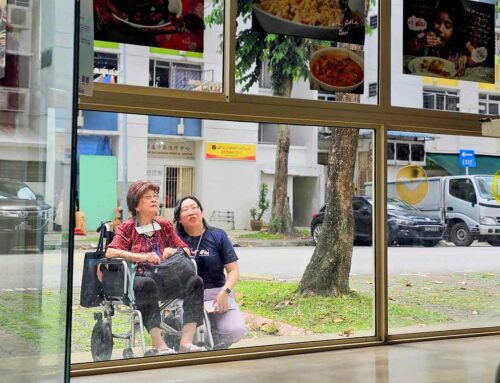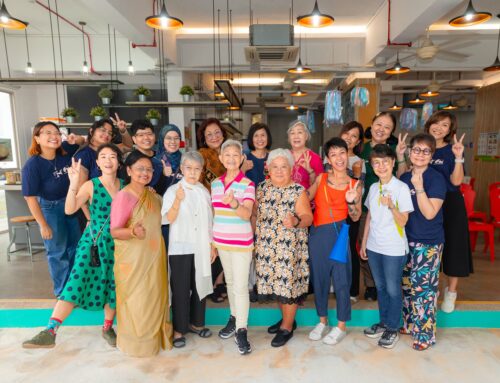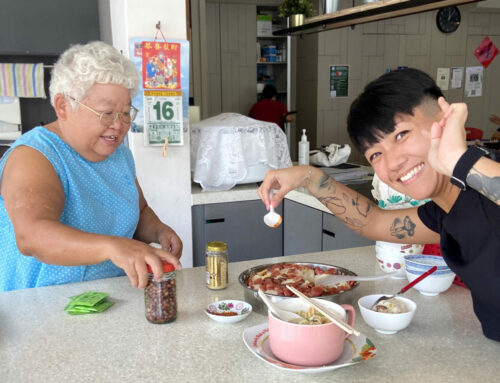Library / Project Journal
Elements of Community Art
Library / Project Journal
Elements of Community Art
By Stacy Huang
02 November 2023
This post is part of a series on our Both Sides, Now project at Wellness Kampung @ 765 Nee Soon Central (2023-24). This year-long project aims to develop supportive communities for living well, and leaving well.
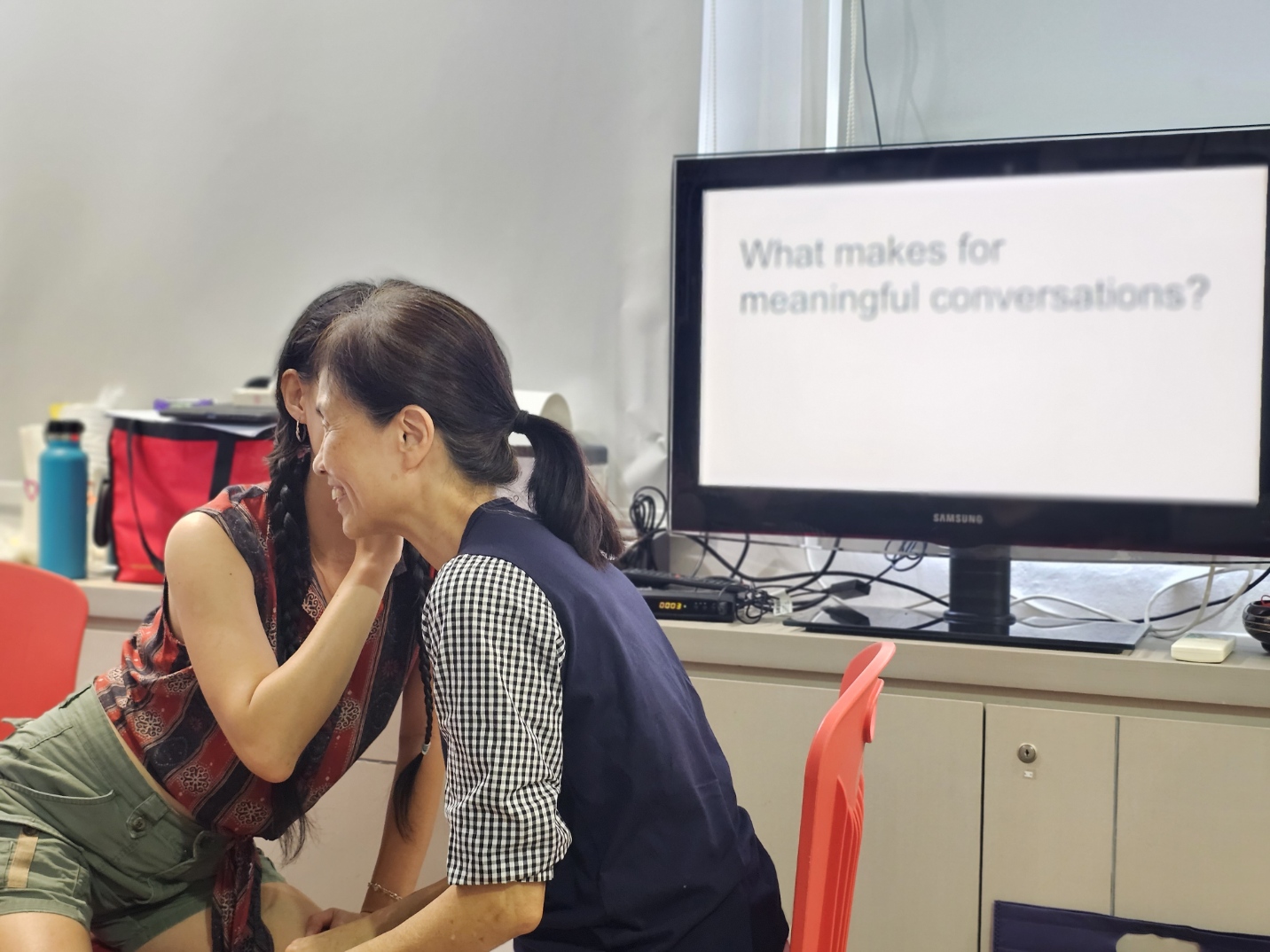
Senior collaborator Agnes Tan and lead artist Salty Xi Jie Ng engaged in a role play exercise on having meaningful conversations at Wellness Kampung @ 765 Nee Soon Central. Photo by Stacy Huang
We were deep into our sixth or seventh session with the senior collaborators in the English session, discussing meaningful conversations and their elements. As we called for a five-minute break, one of the senior collaborators, Shirley Wong —who had newly joined the project then— took this time to ask: “Actually, both of you call yourselves artists, but what is the art that you all are doing over here? It feels to me that this is more like social work.” Her curiosity was shared by the rest of the senior collaborators in the group, who chimed in with, “Yes, can you all tell us more?”
This query took me by surprise. Not in the type of question she was asking, but in the sincerity of her wonderment and the shared sentiment of the group. It filled me with warmth, as it reflected the senior collaborators’ contemplation on our role as artists, the arts and their personal investments in the project.
I have concluded that there is no short answer to this question and trying to come up with one only prevents me from fully expressing the intricacies and layers to this complex art form. The rest of this reflection shows my personal attempt to describe the ‘art’ in ‘community art’ through its fundamental elements — though not tangible nor immediately obvious, but significant and distinct enough that these elements can allow community art to be distinguished from its relatives.
Trust with a capital ‘T’
Trust is a delicate and necessary component of community art; without which, neither the artist nor the community participants can produce any meaningful work – work that ranges from conversations, to reflection, to art making. Imagine trying to guide a stranger to apply their own creativity into expressing opinions, thoughts and stories that are personal to them – how would you begin?
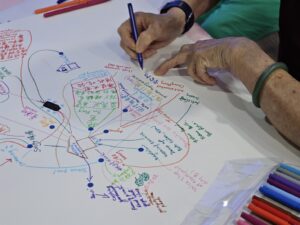
Senior Collaborator Koh Tong Cheng adding on to the working mind map of community resources. Photo by Stacy Huang
With sincerity and commitment, building trust lies in the small acts of showing up for the senior collaborators. This can look and sound like asking about their day, remembering what they shared with you the week before, revealing information about each other’s lives, listening, celebrating, and loving in big and small ways.
Trust, in this manner, is not only built with the participants that are directly involved in the project, but also the community stakeholders and leaders that are present within the ecosystem of what makes a community in the first place. The result of having trust in place, is a support system made of various individuals with their own personalities, stories, perspectives and skill sets – a whole kampung of resources to make creative works.
Tshoara (To hold)
I came across an Instagram reel at some point about how the modern phrase ‘holding space’ exists in the language of SeSotho, spoken in the northeastern provinces of South Africa. The video featured a Sotho woman who shared that in SeSotho, the word for forgiveness (“tshoearelo”) stems from the word “tshoara”, which means to hold. This means that when someone says “forgive me”, they are also saying “please hold for me something I cannot hold for myself.” What a beautiful idea that to hold space is to share a heaviness with a person who cannot bear it alone.
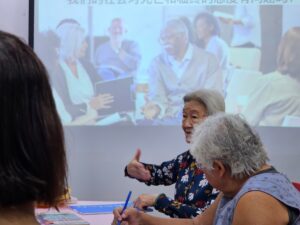
Senior Collaborator Koh Tong Cheng sharing her thoughts on how society regards topics on death.
Photo by Stacy Huang
This is not to say that space is only held for emotions that affect us negatively, but rather for any emotion that we feel deeply. I recall many tender moments during our interactions with the senior collaborators that revealed each of their lives’ accomplishments and struggles, wisdoms and deeply embedded sorrows — manifestations of emotions that are too much to bear on their own. When thought about in this way, the act of holding space proves precious and invaluable in community art. It provides the emotional platform for community participants and artists to come together in an intimate exchange of personal stories that eventually drives the art making process to make meaningful outcomes.
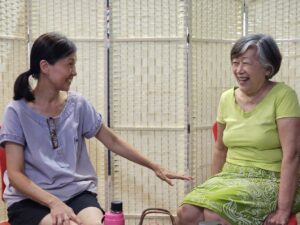
Senior collaborator Agnes Tan and Magdalene Yap engaged in a role play exercise on having end-of-life conversations at Wellness Kampung @ 765 Nee Soon Central. Photo by Stacy Huang
A shared autonomy
Community art is a durational art form. Unlike a painting that is hung on a gallery wall, or a shiny sculpture that stands in the middle of a room, the essence of community art is found primarily in its process. It is found in the journeying with participants and partners alike that involves conversation, reflection, expression and change in creative ways.

Lead artist Salty Xi Jie Ng kickstarting the workshop session with the Mandarin-speaking group of senior collaborators. Pictured (left to right) are senior collaborators Michelle Sim, Chia Yin Fong, and Koh Tong Cheng. Photo by Stacy Huang
In relation to Both Sides, Now at Wellness Kampung @ 765 Nee Soon Central, it begins with these eight senior collaborators – who despite having come from varied walks of life – were motivated to be a part of this project. What started out as individual curiosities on an art project about death has now become a meaningful vehicle and platform for these senior collaborators to channel their innermost thoughts, musings, and desires on living and dying. Creative expression is used as a tool to facilitate this. It starts with a query by the artists that is answered by the seniors, and vice versa, reflecting the shared autonomy between the artist and the participants.
“What is the art that you all are doing over here?” Well, the art is in the lived experiences of the project by every member of the community — artists, senior collaborators and partners alike. The weekly sessions that occupy space within Wellness Kampung @ 765 Nee Soon Central amidst existing programmes. The questions asked by one senior collaborator that provoke another to think about death in a new way. The Yishun Health partner’s newfound understanding of a senior collaborator when a side of their personality is revealed because of the project. The art is in the ripples of transformation within each individual, and the community as a whole. The art is in the creative manifestations that plant a mere seed for more generative changes to come. The art is everywhere – if only you choose to see it.
About Stacy Huang

Stacy is the assistant artist of Both Sides, Now 2023-24 at Wellness Kampung @765 Nee Soon Central. Based in Singapore, she identifies herself as an artist, educator and mediator. She combines the use of art pedagogies, play, and process-based methodologies to facilitate conversations and individualistic expression in community-based settings. Her work often culminates in the form of installations, performance, and mixed media drawings. She most recently co-created a community floor mural with twelve youths as part of the Arts @ Macpherson Trail.


